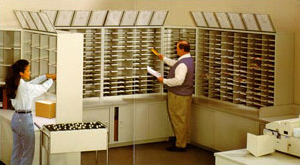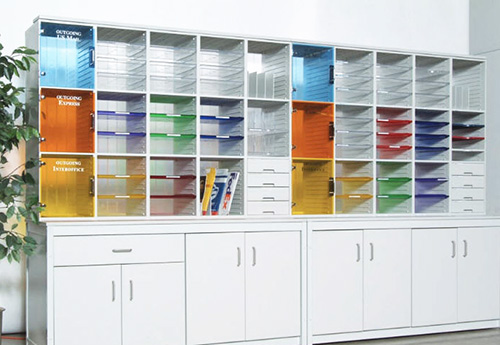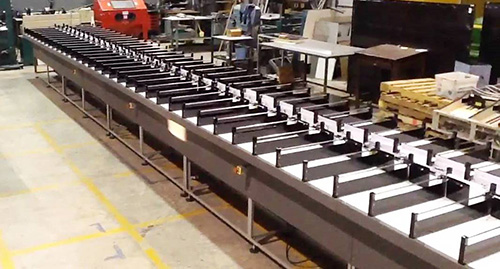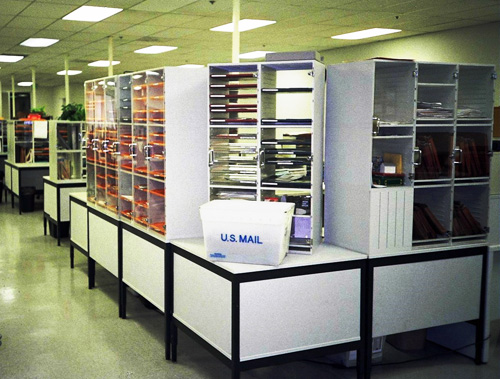Overview
Within This Page
In medium to large commercial and federal facilities, the Mail Center space type is used to efficiently and centrally process incoming and outgoing domestic, international, overnight, and priority mail to meet the needs of building occupants. The Mail Center also collects and redistributes interoffice mail and coordinates the pick-up of "burn bag" materials. A burn bag is a container designed for the disposal of sensitive materials used by businesses and governments to ensure that classified material is safely disposed of in a way that will not permit reconstruction. In general, outgoing expedited, domestic, and international, Certified and Registered, and Pouch Mail Services are also provided. Finally, many Mail Centers can be equipped to handle deliveries from couriers and to provide a level of service and guidance to building occupants. Loading docks are more appropriate for larger deliveries. This space type does not include specialized mail centers in facilities that must deal with an exceptional level of security, although security issues are addressed here.
Space Attributes

A variety of products are available for furnishing mail centers.
Photo Courtesy of Mid-America Business Systems
Numerous manual operations, including the sorting, metering, and inspection of letters and packages, take place in Mail Centers. Mail Centers should be designed not only to promote the efficiency of mail processing but to ensure the safety of center occupants and the center contents. Typical features of Mail Center space types include the list of applicable design objectives elements as outlined below. For a complete list and definitions of the design objectives within the context of whole building design click on the titles below.
Accessible
- Work surfaces: The primary built-in fixtures in mail rooms include base cabinets, work surfaces, and shelving units. Work surface options include laminate, stainless, solid, and anti-bacterial. Ensure that accessible fixtures are provided for users. In particular, provide work surfaces at different heights to accommodate a variety of tasks performed by both standing and sitting users.
Aesthetics
-
Overall design: The Mail Center should provide a healthy and aesthetically pleasing place to work.
-
Cabinetry and fixtures: Cabinetry and fixtures should be aesthetically pleasing as well as versatile and durable.
-
Flooring materials: Whether tile or carpet, flooring should be chosen for a combination of aesthetics, efficiency, and ease of maintenance.

Brightly colored dividers make this mail center easy to organize and aesthetically pleasing.
Cost-Effective
-
Risk Assessment: Security needs will vary among organizations in relation to their function, size, volume of mail, and profile. A threat/vulnerability assessment and cost/benefit analysis should be performed before capital investments are made in security measures. The estimated capital cost of implementing recommended countermeasures and the estimated installation and operating costs for them are usually part of a complete threat/vulnerability assessment report. See also WBDG Threat/Vulnerability Assessments & Risk Analysis.
- Metal Surfaces: Powder coat paint finishes on all metal surfaces to improve durability and aesthetics, which also reduces replacement and maintenance costs over time.
Functional / Operational
-
Adjacencies: The Mail Center should be located away from the facilities' main entrances, areas containing critical services, utilities, distribution systems, and important assets. In addition, the Mail Center should be located at the perimeter of the building with an outside wall or window designed for pressure relief. An area near the loading dock may be a preferred location since this will allow the mail to travel directly to the center from outside and minimize the impact that any potentially contaminated mail will have on the rest of the building.
-
Planning space: Although many individuals may visit the Mail Center on occasion, even large corporate Mail Centers may only have one to a few employees directly responsible for Mail Center operations. The space type should be designed for utility and efficiency, keeping in mind that only a small number of users may be in the space at a given time. See also WBDG Functional/Operational—Account for Functional Needs.
-
Noise Reduction: Speech privacy is not a significant consideration in Mail Centers. However, if centers are adjacent to open plan areas, a minimum of 80% of ceiling surfaces should be treated with sound-absorptive materials. Wherever possible, these same corridors should be carpeted.
-
Provide lockers: Provide lockers or personal space for employees' belongings outside of the Mail Center. This will encourage users not to bring their personal belongings into the main mail processing space where the items could become obtrusive or contaminated by hazardous materials or could represent a potential safety threat.
-
Integrated Technology: Begin the design process with a thorough understanding of the technological requirements of the space, including anticipated future needs. E-commerce and data-driven technology have emerged, creating an exponential increase in purchase orders and package volumes, resulting in more misrouted items and an inability to close the accountability loop. More sophisticated requirements are a necessity as mail center managers need solutions to address incoming supply and shipment requests, higher call volumes, and more stringent delivery expectations. Service request forms and management, client-facing portals, virtual mailboxes, locker/mailbox management, purchase order (P.O.) line item receiving, and outbound desktop shipping are among the technological tools designed to support the changing Mail Center. See also WBDG Functional/Operational—Ensure Appropriate Product/Systems Integration.
-
Occupancy: Mail Center space types fall into the B2 occupancy classification, with sprinklered construction. The GSA acoustical class is D1 for mailrooms.

Mail sorting machine
Productive
-
Flexibility: The Mail Center space type is durable and adaptable, and will typically include features such as a raised floor system for the distribution of critical services (power, voice, data, and HVAC) and mobile workstations to accommodate changes in employee, equipment, and storage needs over time. See also WBDG Productive—Design for the Changing Workplace.
-
Lighting: Incorporate natural daylight whenever possible along with high-efficiency lighting and task lighting that makes it possible for each employee to be productive in their individual type and area of work.

The use of light-colored mail sorting units and ample overhead lighting make this mail center a pleasing and productive place to work.
Secure / Safe
-
Biological Threats and Irradiation: According to the U.S. General Services Administration (GSA), the threat of biological and chemical attacks occurring at Mail Centers exists. See the GSA web page, Mail Center Security, for detailed information on threat reduction and mitigation.
-
Provide signage: Provide signage that details emergency operations procedures and evacuation routes. This is the most effective and important step towards preparing to deal with emergencies and suspicious packages and letters.
-
Restrict access: To prevent theft and or contamination of mail, control and limit access of employees, known visitors, and escorted visitors to the Mail Center with sign-in sheets, badges, and/or card readers (for large mail operations restricted areas also include plants and workroom floors). If possible, make the Mail Center an enclosed room with defined points of entry. If the Mail Center cannot be in its own room, set aside a defined space that is only used for processing mail.
-
See also WBDG Secure/Safe—Security for Building Occupants and Assets.
-
Prevent access by unauthorized persons: Provide locking mechanisms on all Mail Center doors so that doors can be kept locked whenever possible, especially when no one is on duty. Subject to emergency exit safety requirements, keep all outside doors locked and provide means from preventing doors from being propped open. In addition, provide a restricted, defined area for all deliveries and pick-ups. Restrict drivers to an area that is separate from the production/Mail Center facilities.
-
Monitor entry to the facility: Provide video cameras inside and outside the facility and its docks and/or position a center supervisor's office within view of primary entrances and exits in order to monitor entry into the facility. Ensure that supervisors and team leaders will be clearly visible from the work floor.
-
Prevent theft: Mail is sometimes lost or stolen from company Mail Centers, or while en-route to or from the Post Office. Much of this mail is quite valuable. Incorporate preventative measures into the design of the space. For example, provide a processing center for Registered Mail™ separate from other mail. Provide locking cabinets to secure fund related equipment like postage meters that are not in use.
-
Encourage hand washing: To limit exposure to potentially hazardous materials, provide a sink in the mail room to encourage employees to wash hands frequently, especially prior to eating.
-
Blast resistance: Mail Centers where packages are received and opened for inspection should be designed to mitigate the effects of a blast on primary vertical or lateral bracing members. Where these rooms are located in occupied areas or adjacent to critical utilities, walls, ceilings, and floors, they should be blast and fragment resistant. In the event of a blast, the areas adjacent to the mailroom should not experience severe damage or collapse. See also WBDG Designing Buildings to Resist Explosive Threats.
-
Ventilation: Where the risk assessment, the volume of mail, and a cost-benefit analysis make it appropriate, the Mail Center should have its own air handling and ventilation system. Consider establishing negative air pressure for the area where processing incoming mail will occur or for the entire Mail Center. If a separate processing area is used, it should not be part of the central ventilation system. Shut-off points of processing area's ventilation system should be mapped and should be part of an emergency procedures handout. See also WBDG Air Decontamination.
-
HEPA filters: Down-draft high efficiency particulate air (HEPA) filters are a good way to limit employee exposure to routine dust as well as possible airborne hazards.
-
Biochemical hood: For high profile organizations that see or may see suspicious packages on a regular basis, provide a biochemical hood, which has negative pressure, for the inspection of packages.
- Material disposal: Provide adequate space in the Mail Center for explosive disposal containers and covered containers for paper waste including envelopes, packages, and boxes. Paper waste should be transported to the loading dock for removal.
Sustainable
-
Energy Efficiency: As energy costs increase with higher reliance on technology, strategies such as the specification of high-efficiency lighting and lighting controls; the application of daylighting; the use of occupancy sensors; and the installation of high-efficiency HVAC equipment should be considered. For more information, see WBDG Sustainable—Optimize Energy Use.
-
Furnishings and finishes: Incorporate Low or No-VOC materials and antibacterial surfaces, furnishings, and fixtures to ensure a healthy indoor environment.
- Recycling: Promote recycling programs to reduce trash to landfills. Utilize recyclable packaging to reduce waste and costs.
Relevant Codes and Standards
The following agencies and organizations have developed codes and standards affecting the design of Mail Centers. Note that the codes and standards are minimum requirements. Architects, engineers, and consultants should consider exceeding the applicable requirements whenever possible:
- Executive Order 13834, "Regarding Efficient Federal Operations"
- GSA PBS-P100 Facilities Standards for the Public Buildings Service
- GSA Guidelines for Safe Mail Centers
- GSA Mail Management
- ICC IBC International Building Code
Additional Resources
Publications
- Best Practices for Mail Screening and Handling Processes: A Guide for the Public and Private Sectors by the U.S. Department of Homeland Security and the Interagency Security Committee, September 27, 2012.
- U.S. Postal Service
- Best Practices for Mail Center Security
- National Energy Management Strategy








